By: Patrick W. Zimmerman
The Donald wants you to live in a world of eternal threat, where the Evil minions of Radial Islamic TerrorTM are lurking in every shadow, pouring over the border to kill you and then take your job after they finish collecting your unemployment. Because they hate your freedom, your mom’s freedom, and your freedom fries, probably.
If the ban were announced with a one week notice, the "bad" would rush into our country during that week. A lot of bad "dudes" out there!
— Donald J. Trump (@realDonaldTrump) January 30, 2017
This kind of anti-immigrant scaremongering isn’t particularly new.
In recent decades, a clash of civilizations has been invoked, most notably by President George Bush II (“This struggle has been called a clash of civilizations. In truth, it is a struggle for civilization.” is one of the clearer references) to politically frame an earlier version of the War on Terror. Many of the protagonists in Trump’s version of this struggle are essentially the same; he emphasizes the US’s role as victim more than his predecessors, but, in terms of discourse, swapping ISIS in for Al-Qaeda does little to affect the broader elision of differences between a community of believers (dar al-Islam) and the violent radicals which arose out of that community (insert terrorist organization du jour). Southerners who are tired of being tarred with the reputation of the Ku Klux Klan should be able to relate.
Great. The new boss, very slightly different than the old old boss. So what? Why focus on the discourse surrounding hate and terror?
Well, for several reasons. First, hate, fear, terror, and citizenship were both fundamental to the ideology of Trump’s campaign and a central focus of his administration. Second, by looking at what kind of dangers Trumpism warns which people about, including both hate crimes and more over-the-top acts of terrorism, we can infer with relative accuracy who is included in its imagined community and who is defined as an other, an outsider, a semicitizen, or an interloper.
The question
Who does Trump feel belongs, and who doesn’t?
How does this new, Trump-flavored version differ from the others? Who, exactly should be afraid, and from whom?
To try to tease that out, we looked at every public denunciation of a hate crime or hate-motivated terrorist act by the Leader of the Free World since Election Day (8 November 2016), segmenting the data by race and religion of both the victims and the attackers. Only contemporary incidents were counted, so 9/11 and the Holocaust are not included.
Note: Thanks to @katealamode for the original idea for this project.
The short-short version
Trump wants you to be afraid. Be very afraid. As long as you’re Christian and White.
Those of you who are Jewish or non-white Christians should probably go ahead and be afraid, too, but you’re not really as important to the President.
Trump’s condemnations were heavily slanted towards warning about hate specifically directed by Middle Eastern Muslims against White Christians, both when breaking down race and religion on a per-incident basis as well as when considering them as a percentage of casualties (dead + wounded). Sure, you get no prizes for guessing this, but here’s some hard evidence to back up your perception of our Commander-in-Chief’s pretty overt biases.
In short, when Trump denounces hate targeting Christians spontaneouslybut all other types only reluctantly (or ignored altogether), it strongly hints at his worldview.
One of the two-thirds of women who don’t report sexual assault?
Sorry, your fears aren’t shared by the President. You must not be real Americans.
Psst! In a hurry and just want to see the data? Jump straight to the pretty charts.
Enemies and Others, both foreign and domestic
Want to know who belongs in Trump’s America, according to the Donald? Pay attention to who he defines as an enemy and who he feels needs protection from those evildoers. Specifically, we looked at his (highly) asymmetrical statements on hate and terror to piece together who is US and who is Them (see what we did there?).
One of the Trump administration’s defining traits is its profoundly orientalist tendency to view the Middle East as culturally homogeneous, static, backwards, and savage. In this warped cosmology, the vague area on the map East of Greece and West of India is a breeding ground for “Radical Islamic Terrorism,” an ubiquitous catch-all shorthand wielded bluntly by the administration to define one of the major Others in its worldview. Factions within the administration (particularly Stephen Bannon and the rumored-to-be-on-his-way-out Sebastian Gorka), even see a “stealth jihad” or “soft jihad” of sneaky crypto-Muslims trying to impose Sharia law in the US (clarification: evidence for this = 0).
Compared to its predecessors, Trumpism has been more overt in its willingness to define the world’s over 1.6 billion Muslims as dangerous, legislatively as well as discursively. The Bush White House at least made a public effort to point out that the War on Terror was “not a campaign against the Muslim faith” and indeed framed the wars in Iraq and Afghanistan as attempts to democratize Islamic societies (rather than eradicate the religion itself). Whether or not you find the public attempts to justify Bush’s foreign policy believable, the old excuse of the mission civilisatrice is notably absent from Trump’s calls for troop deployments to Afghanistan or in the announcement of the US missile strike against a Syrian airbase.
Trump’s administration has also been much more active at publicly calling out and defining its enemies outside of the (politically safe) category of “terrorist groups.” Bad hombres, the “fake news media,” the Democrats, black inner-city war-zones, and sanctuary cities are all seen through an exotic lens. To Trumpism, they represent “they”, “them”, to contrast with the uneducated slice of white America. They are not part of “the Movement.”
Well, we all did it, together! I hope the "MOVEMENT" fans will go to D.C. on Jan 20th for the swearing in. Let's set the all time record!
— Donald J. Trump (@realDonaldTrump) December 16, 2016
Bush II may have most famously argued that “Either you are with us, or you are with the terrorists,” (or was it Hillary?) but he was very specifically talking about an international context, of nation-states that should ally with the US in its War on Terror (so was Clinton, by the way). Trump’s conception of enemies elides the difference between foreign and domestic, which is clearly reflected in his early executive actions. Trump’s first moves to protect his America? Ban Muslim travel into the country (blocked), ramp up the deportation of (mostly Latin@, mostly non-criminal) immigrants by ICE, and demand the construction of a wall on the US’ Southern border (unfunded, so far). He has been working to protect Movement America from enemies “pouring” over the border (from places like the Middle East and Mexico),
....the wall is not built, which it will be, the drug situation will NEVER be fixed the way it should be!#BuildTheWall
— Donald J. Trump (@realDonaldTrump) April 24, 2017
I promise to rebuild our military and secure our border. Democrats want to shut down the government. Politics!
— Donald J. Trump (@realDonaldTrump) April 27, 2017
Trump is concerned with some hate crimes and terror attacks more than others
The victims whose injury, death, or trauma Trump has lamented have been overwhelmingly white and Christian, with the sole significant exception the Palm Sunday bombings in Egypt that also targeted Christians….but non-white ones.
This correlates very well with how Trump has called out Europe (and several times, France specifically) as besieged by Radical Islamic Terror, exhorting the US to “GET SMART” (no, he doesn’t mean ), or, he implies, you’ll be next!
Our country needs strong borders and extreme vetting, NOW. Look what is happening all over Europe and, indeed, the world - a horrible mess!
— Donald J. Trump (@realDonaldTrump) January 29, 2017
A new radical Islamic terrorist has just attacked in Louvre Museum in Paris. Tourists were locked down. France on edge again. GET SMART U.S.
— Donald J. Trump (@realDonaldTrump) February 3, 2017
The attackers that Trump has condemned have been….wait for iiiiiittttt…mostly Muslims with Middle Eastern ethnic backgrounds. I know, shocking, right?
When specifically pressured, Trump will denounce White supremacist vandalism and anti-semitism, but, with the exception of the mistaken-identity-driven murder of an Indian man in Kansas, he has not yet done so unless put on the spot.
Observation 1 – Violence and hate crimes against white Christians by others => immediate, spontaneous response by Trump.
Observation 2 – Violence and hate crimes against by any other group against any other group => Trump response only if directly prompted or pressured.
Conclusion – systematic bias.
The administration’s silence around rising anti-LGBTQ violence and active participation in the intimidation, profiling, and incarceration of Latin American immigrants and citizens further adds to the evidence in favor of Trump’s rather restricted definition of America.
The full map
Hover over each incident for details on the attack and Trump’s reaction to it. Toggle the Victim and Attacker categories on the right-hand side to segment the dataset by race or religion.
What’s missing?
Hate crimes are rapidly increasing in frequency across the US, both fueled by and a cause of the 2016 election campaign and the Trump’s connection to the white nationalist right.
Trump does not seem particularly likely to expand his definition of what it means to be American. He’s 70 years old, and old white men are not known for radically re-articulating their ideologies. So that means that it’s up to the rest of us to do so. Yes, you.
Turn Homeland Security’s advisory on its head; if you see a something, say something, even to the seemingly mundane and quotidian expressions of discrimination you’d typically ignore. Celebrate Ian Grillot, the 24 year-old Kansan who tried to intervene in the Olathe shootings (earning two bullets for his trouble).
Keep an eye on the hate crimes as they happen and disavow those who perpetrate them. Vote with your mouth, your legs, and your wallet. Keep an eye on the radical right.
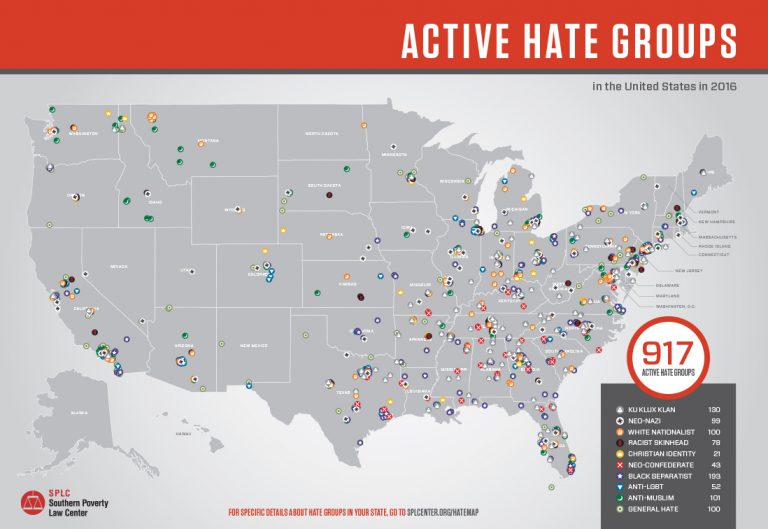
The Southern Poverty Law Center is a good place to start.
The new authoritarianism seeks to silence the Other so, we’ll just have to shout a little louder, won’t we?



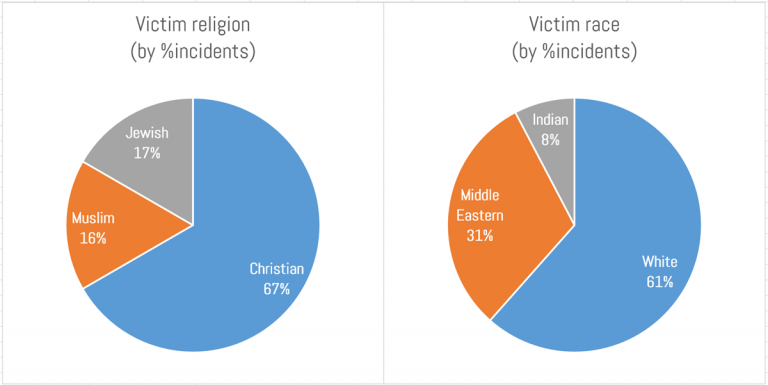
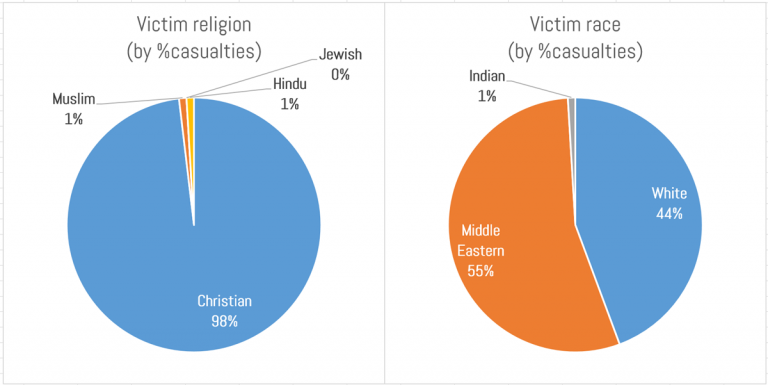
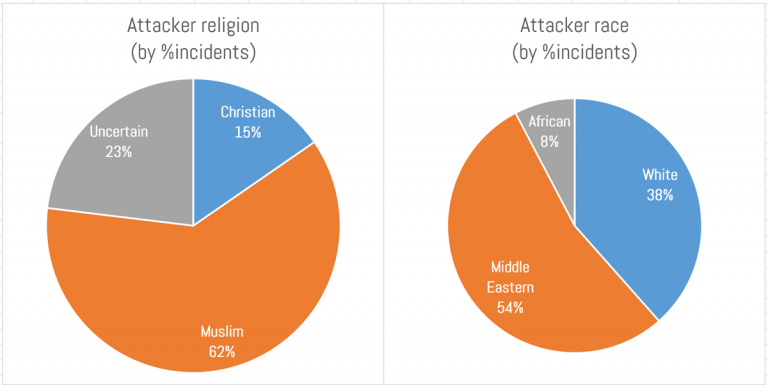
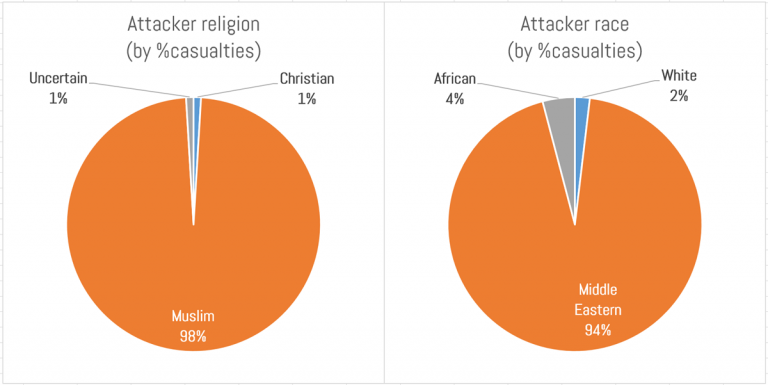
No Comments on "What kinds of terror and hate crimes does Trump denounce, and what does that say about the world he wants you to believe in?"